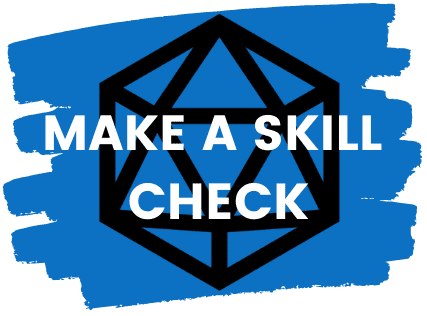On the go? Listen to the audio version of the article here:
The Player Character (PC) that you play in D&D is an integral part of the game, as they are the vessel through which you interact with the fantasy world. But there are many reasons you might want to play another character. Feeling stuck with your current PC can drain the excitement out of the game quickly. Is there an alternative? Is the only option to kill off your old PC?
After getting permission from your DM, every player can easily change characters by having their current one leave the party for any reason, big or small. That reason could be anything from retirement to starting a business to becoming a villain.
Changing characters is a big decision. How do you know it’s the right thing to do, and how do you go about it? There are a few key factors to consider when making this decision.
Let’s explore that together.

Table of Contents
How to Change Characters in D&D
The first thing you need to do is talk to your DM and tell them why you want to change. They might have rules and costs in place for players who want to do this.
For example, what level will your new PC be? What items can they have? Will they have to prove themselves to gain the trust of the party?
What happens to your old PC? They don’t need to die, so before you rush that wizard headfirst into battle, consider finding both a moment and an in-game reason for your PC to part ways.
Perhaps your PC is returning home to be with their loved ones, or they’ve given up the dangerous life of an adventurer. Perhaps they have a personal quest that whisks them away, or they become enemies with a party member and leave.
All of these options are viable and will largely depend on a key question: how do you want your old PC to be treated in the future?
- Do you want them to be left to live peacefully?
- Are you okay if they show up later as a non-player character (NPC)?
- Do you want to reserve the option to play them again?
Many DMs would entertain the idea of turning your old PC into a future villain or Big Bad. If this is something you are against, make that clear.
As you determine why your PC is leaving the adventuring party, work with your DM to find a moment in the campaign that would be fitting for a send-off.
In the middle of a dungeon, it won’t make sense for your PC to leave because they want to start a new business. Well, unless they’re especially cowardly by nature.
Generally, it’s recommended to wait until you’re back in town so your PC can say goodbye as they go off on their business venture or, if you can’t wait, maybe your PC is taken away by a powerful monster in the dungeon. Does this mean they became food, a slave, a convert? Who knows!
The next thing to consider is how your new character will join the adventuring party.
When you’re making your new character, think about what common goals that they would have with the existing party. Why would a tightly formed group accept this newcomer?
The other players know that they’re supposed to accept you because they know it’s a game and you’re playing. Give their characters a reason to have your character join them as well. For example, you could be after the same villain for your own reasons.
The process of changing characters is straightforward, but there are key factors to consider before making this decision.
Why Should You Change Characters?
There are two general reasons why changing characters is a good idea. The first is an in-game reason, and the second is an out-of-game reason.
Firstly, in-game, you should consider changing the character that you play if your current character’s goals do not align with the party’s.
When you sat down to play D&D with your friends, you decided that your characters would all be working together.

But as your characters develop, you could realize that your character wants to accomplish something that can’t be done with the party. It’s easy to feel locked into playing this character because, without them, you wouldn’t be playing D&D with your friends.
However, consider having your current character decide to pursue their own goal and create a new character that aligns more clearly with the rest of the party.
Secondly, out-of-game, you might be bored playing as your current character. Maybe you made the character before you knew what you really wanted to play, or maybe you’re excited by a new character idea that you had.
While you probably don’t want to be changing characters every week, consider changing characters so that you can play as someone that you enjoy playing.
If you didn’t know, you should have fun when playing D&D!
How to Enjoy Playing Your Current Character
Your character is hopefully more than just a bunch of stats on a page.
They have their own personality, hopes, desires, relationships, and flaws. If you’re considering changing characters because you don’t like the subclass you chose or the role that you play in the party, playing a brand new character isn’t your only option.
Maybe you started playing a cleric, and you don’t want to be cornered into being the healer of the party.
Talk to your DM and to the other players about your character. Let them know that you don’t find being the healer fun, and tell them why you wanted to play this cleric. Communication is key!
Ask your DM if health potions could be more readily available in the world or if other means of healing are available so that you didn’t have to spend every turn healing others. Consider the Healing Surge alternative rule.
Looking to challenge your players?
Puzzles and Riddles can be tricky! Too easy and they’re pointless; Too hard and it’s pure frustration. What is a DM to do?
Well, our friends over at Dungeon Vault have an assortment of puzzles, riddles, and tokens to enhance your gaming experience. They even have a murder mystery and a political intrigue system!
For easy-to-use resources for any D&D game, check out the selections at Dungeon Vault!
Perhaps you love who your character is. You love playing as them, voicing them, cosplaying them, and you’re dedicated to pursuing their goals. However, the subclass is a bummer.
Talk with your DM about changing your subclass while still playing as the same character.
Tasha’s Cauldron of Everything (TCE) introduced official options for changing your subclass. When you reach a new level that would add a new subclass feature, you can switch to another subclass and replace all of your current subclass abilities with those from your new subclass. Bam! Almost like a new character.
For example, a paladin could change their sacred oath when they reach Level 7, Level 15, or Level 20.
A paladin who changes from the Oath of Devotion to the Oath of the Ancients at Level 15 would replace their Oath Spells, their Channel Divinity options, and would replace Aura of Devotion and Purity of Spirit with Aura of Warding and Undying Sentinel.
Talk with your DM about why your character is making this change. Is this a change that your character works towards over time, or does it happen immediately?
Your DM might require you to spend days training equal to twice your new level, an expenditure of gold to pay for training equal to 100 gp times your new level, and even a quest that is relevant to this change. In the above lvl 15 change, this would mean 30 days training, 1500 gp, and a relevant quest.
Or perhaps the change happens immediately. What significant event brought about such a radical change? Was your paladin betrayed by someone close to them and swore an oath of vengeance? It can add some additional flavor to a bland character.
Summary
Changing your PC is an easy process, but it is not the only solution if you are not enjoying your current one.

It is important to ask yourself and your DM these questions:
- Do I enjoy playing my current PC? (Maybe don’t ask your DM this)
- Do my PC’s goals align with the party’s?
- Do I want to play a different role or a different character?
- What costs are involved in changing PCs?
Talk with your DM through this process and how it could work. If you go ahead with it, make sure that you are clear with how your old PC is treated and how your new PC will join.
And no matter what you choose, remember to have fun!







0 Comments